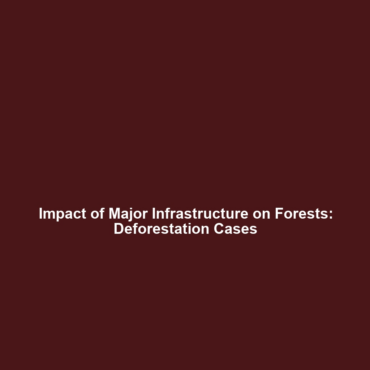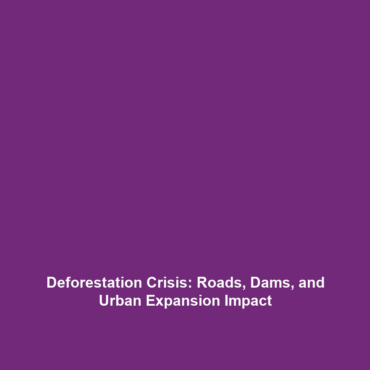Examples of Large-Scale Infrastructure Projects Leading to Forest Destruction
Category: Deforestation & Biodiversity Loss
Introduction
Large-scale infrastructure projects such as Amazon highway projects and hydropower dams have significant implications for deforestation and biodiversity loss. These ventures, often hailed as progress and development, can lead to the irreversible destruction of forests, threatening ecosystems and the myriad species that inhabit them. Understanding the relationship between infrastructure projects and environmental degradation is essential for fostering sustainable practices and making informed decisions regarding land use and conservation policies.
Key Concepts
Infrastructure Projects and Their Impact
Infrastructure projects, including highways, dams, and urban developments, are major contributors to forest destruction. They fragment habitats, promote illegal logging, and increase human encroachment into remote areas. Key concepts related to this issue include:
- Habitat Fragmentation: The division of ecosystems that limits species’ natural behaviors and their ability to thrive.
- Deforestation Rates: The measurement of forest loss over time, exacerbated by infrastructure development.
- Biodiversity Metrics: Indicators that assess the variety of life in ecosystems, significantly reduced due to forest destruction.
Applications and Real-World Uses
Understanding how infrastructure projects contribute to deforestation and biodiversity loss has real-world applications. The examples of Amazon highway projects and hydropower dams articulate the necessity for effective environmental impact assessments and sustainable development methodologies.
- Amazon Highway Projects: These roads improve access to remote areas, but they also facilitate illegal activities that devastate forests.
- Hydropower Dams: Although they provide renewable energy, their construction can flood vast forest areas, leading to habitat destruction.
Current Challenges
Studying the impact of large-scale infrastructure projects on deforestation presents several challenges:
- Data Availability: Limited data on deforestation rates and biodiversity loss in remote regions complicates research.
- Political and Economic Pressures: The prioritization of economic growth over environmental conservation can hinder protective measures.
- Public Awareness: A general lack of awareness regarding the ecological consequences of infrastructure projects may limit community opposition.
Future Research and Innovations
As the world seeks more sustainable development models, future research will focus on mitigating the impact of infrastructure projects on forests. Innovations may include:
- Green Infrastructure: Integrating ecosystems into urban planning to enhance biodiversity preservation.
- Eco-friendly Construction Methods: Developing technologies that minimize environmental disruption during projects.
Conclusion
Large-scale infrastructure projects, exemplified by Amazon highway projects and hydropower dams, are crucial factors in the ongoing battle against deforestation and biodiversity loss. Recognizing their impact is the first step toward implementing effective policies that balance development and environmental conservation. It is imperative for policymakers, stakeholders, and communities to come together, advocate for sustainable practices, and promote awareness about the significant consequences of infrastructure development on our forests.
For more on the topics of deforestation and biodiversity conservation, explore our other articles on solutions to deforestation and the impact of urban development on biodiversity.

